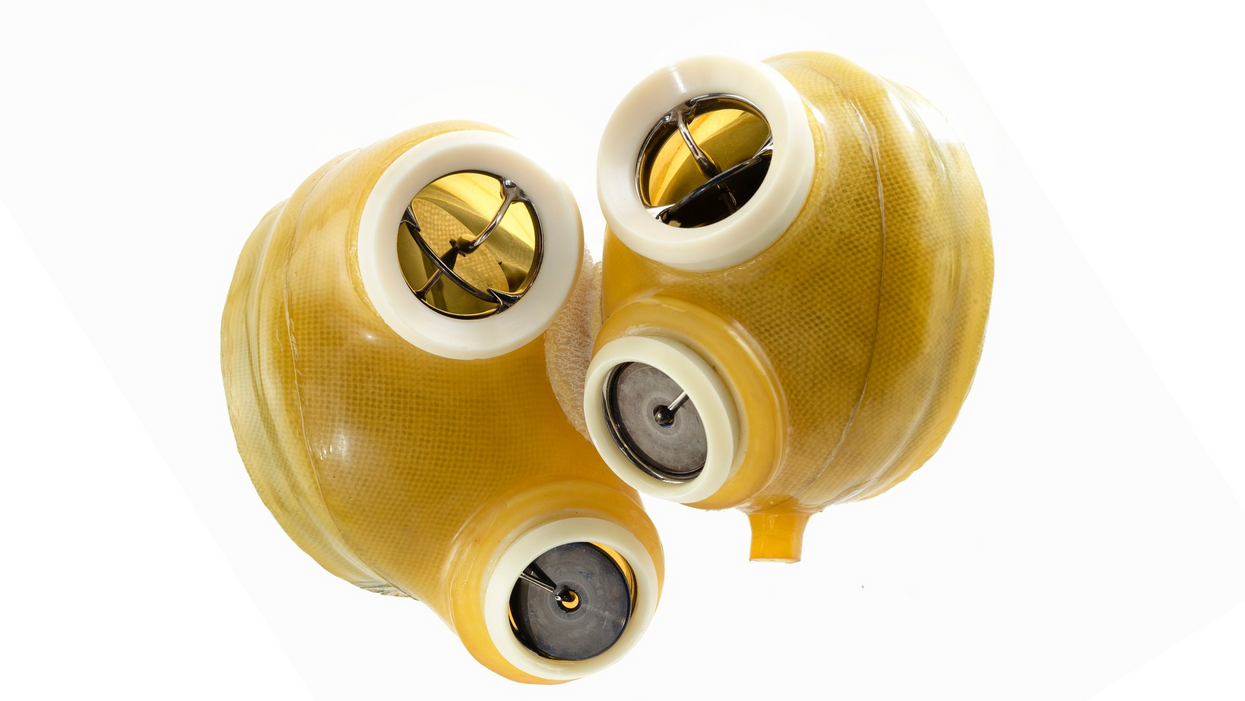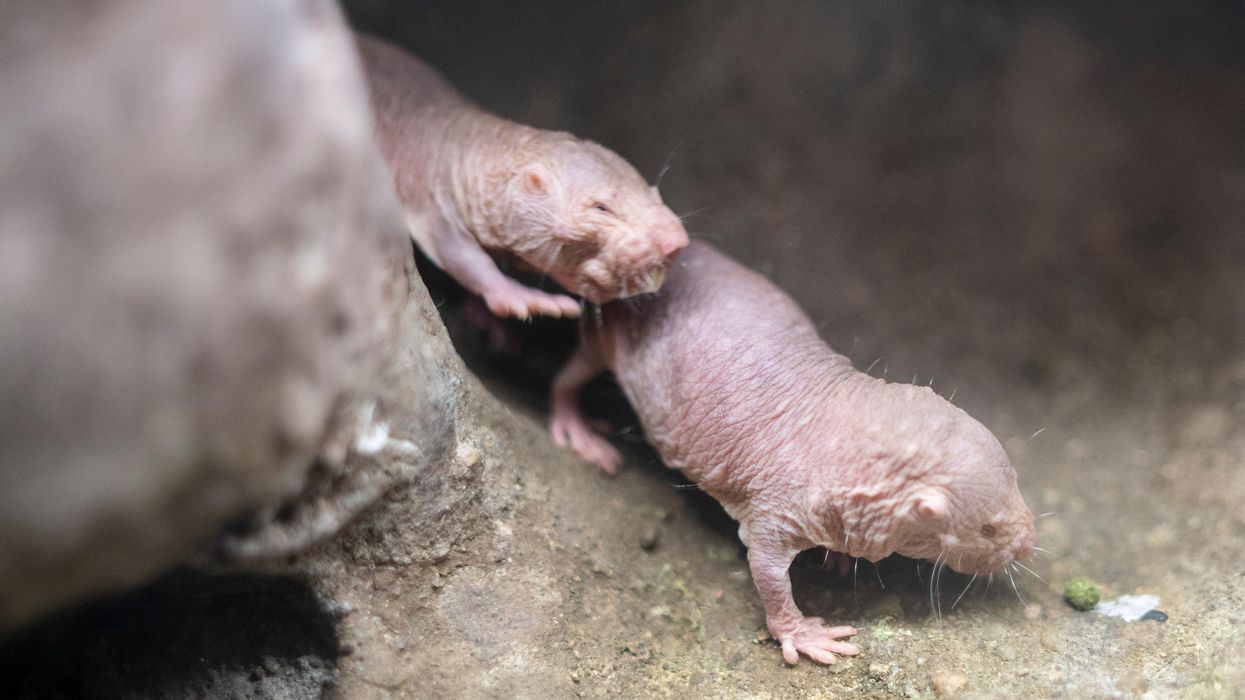The Voice Behind Some of Your Favorite Cartoon Characters Helped Create the Artificial Heart

This Jarvik-7 artificial heart was used in the first bridge operation in 1985 meant to replace a failing heart while the patient waited for a donor organ.
In June, a team of surgeons at Duke University Hospital implanted the latest model of an artificial heart in a 39-year-old man with severe heart failure, a condition in which the heart doesn't pump properly. The man's mechanical heart, made by French company Carmat, is a new generation artificial heart and the first of its kind to be transplanted in the United States. It connects to a portable external power supply and is designed to keep the patient alive until a replacement organ becomes available.
Many patients die while waiting for a heart transplant, but artificial hearts can bridge the gap. Though not a permanent solution for heart failure, artificial hearts have saved countless lives since their first implantation in 1982.
What might surprise you is that the origin of the artificial heart dates back decades before, when an inventive television actor teamed up with a famous doctor to design and patent the first such device.
A man of many talents
Paul Winchell was an entertainer in the 1950s and 60s, rising to fame as a ventriloquist and guest-starring as an actor on programs like "The Ed Sullivan Show" and "Perry Mason." When children's animation boomed in the 1960s, Winchell made a name for himself as a voice actor on shows like "The Smurfs," "Winnie the Pooh," and "The Jetsons." He eventually became famous for originating the voices of Tigger from "Winnie the Pooh" and Gargamel from "The Smurfs," among many others.
But Winchell wasn't just an entertainer: He also had a quiet passion for science and medicine. Between television gigs, Winchell busied himself working as a medical hypnotist and acupuncturist, treating the same Hollywood stars he performed alongside. When he wasn't doing that, Winchell threw himself into engineering and design, building not only the ventriloquism dummies he used on his television appearances but a host of products he'd dreamed up himself. Winchell spent hours tinkering with his own inventions, such as a set of battery-powered gloves and something called a "flameless lighter." Over the course of his life, Winchell designed and patented more than 30 of these products – mostly novelties, but also serious medical devices, such as a portable blood plasma defroster.

| Ventriloquist Paul Winchell with Jerry Mahoney, his dummy, in 1951 |
A meeting of the minds
In the early 1950s, Winchell appeared on a variety show called the "Arthur Murray Dance Party" and faced off in a dance competition with the legendary Ricardo Montalban (Winchell won). At a cast party for the show later that same night, Winchell met Dr. Henry Heimlich – the same doctor who would later become famous for inventing the Heimlich maneuver, who was married to Murray's daughter. The two hit it off immediately, bonding over their shared interest in medicine. Before long, Heimlich invited Winchell to come observe him in the operating room at the hospital where he worked. Winchell jumped at the opportunity, and not long after he became a frequent guest in Heimlich's surgical theatre, fascinated by the mechanics of the human body.
One day while Winchell was observing at the hospital, he witnessed a patient die on the operating table after undergoing open-heart surgery. He was suddenly struck with an idea: If there was some way doctors could keep blood pumping temporarily throughout the body during surgery, patients who underwent risky operations like open-heart surgery might have a better chance of survival. Winchell rushed to Heimlich with the idea – and Heimlich agreed to advise Winchell and look over any design drafts he came up with. So Winchell went to work.
Winchell's heart
As it turned out, building ventriloquism dummies wasn't that different from building an artificial heart, Winchell noted later in his autobiography – the shifting valves and chambers of the mechanical heart were similar to the moving eyes and opening mouths of his puppets. After each design, Winchell would go back to Heimlich and the two would confer, making adjustments along the way to.
By 1956, Winchell had perfected his design: The "heart" consisted of a bag that could be placed inside the human body, connected to a battery-powered motor outside of the body. The motor enabled the bag to pump blood throughout the body, similar to a real human heart. Winchell received a patent for the design in 1963.
At the time, Winchell never quite got the credit he deserved. Years later, researchers at the University of Utah, working on their own artificial heart, came across Winchell's patent and got in touch with Winchell to compare notes. Winchell ended up donating his patent to the team, which included Dr. Richard Jarvik. Jarvik expanded on Winchell's design and created the Jarvik-7 – the world's first artificial heart to be successfully implanted in a human being in 1982.
The Jarvik-7 has since been replaced with newer, more efficient models made up of different synthetic materials, allowing patients to live for longer stretches without the heart clogging or breaking down. With each new generation of hearts, heart failure patients have been able to live relatively normal lives for longer periods of time and with fewer complications than before – and it never would have been possible without the unsung genius of a puppeteer and his love of science.
Naked Mole Rats Defy Aging. One Scientist Has Dedicated Her Career to Finding Out How.
Naked mole rats have extraordinarily long lifespans and are extremely resistant to cancer.
Rochelle "Shelley" Buffenstein has one of the world's largest, if not the largest, lab-dwelling colonies of the naked mole rat. (No one has done a worldwide tabulation, but she has 4,500 of them.) Buffenstein has spent decades studying the little subterranean-dwelling rodents. Over the years, she and her colleagues have uncovered one surprising discovery after another, which has led them to re-orient the whole field of anti-aging research.
Naked mole rats defy everything we thought we knew about aging. These strange little rodents from arid regions of Africa, such as Kenya, Ethiopia and Somalia, live up to ten times longer than their size would suggest. And unlike virtually every other animal, they don't lose physical or cognitive abilities with age, and even retain their fertility up until the end of life. They appear to have active defenses against the ravages of time, suggesting that aging may not be inevitable. Could these unusual creatures teach humans how to extend life and ameliorate aging?
Buffenstein, who is senior principle investigator at Calico Life Sciences, has dedicated her life to finding out. Her early interest in the animals of what is now Zimbabwe led to her current position as a cutting-edge anti-aging researcher at Calico, the Google-funded health venture launched in 2013. The notoriously secretive company is focused on untangling the mysteries of why animals and people age, and whether there are ways to slow or temporarily arrest the process.
The small, wrinkly animal, which lives in underground burrows in the hot, arid regions of Africa, is hardly the beauty queen of the mammalian kingdom. Furless, buck-toothed and tiny-eyed, the creatures look like they could use a good orthodontist, a protective suit of clothes and possibly, some spectacles to enhance their eyesight. But these rats more than make up for their unimpressive looks with their superlative ability to adapt to some of the most inhospitable conditions on earth.
Based on the usual rule that body size predicts lifespan, naked mole rats shouldn't live that long. After all, similarly-sized rodents like mice have a life expectancy of two years or less. But Buffenstein was one of the first scientists to recognize that naked mole rats live an extraordinarily long time, with her oldest animal approaching 39 years of age. In addition, they never become geriatric in the human sense, defying the common signs of aging — age-related diseases, cognitive decline and even menopause. In fact, the queens, or females that do all the breeding in a bee-like underground colony, remain fertile and give birth to healthy pups up until what would be considered very old age in humans. And the naked mole rat has other curious abilities, such as the ability to endure extreme low-oxygen, or hypoxic, conditions like those they encounter in their underground nests.
"One thing we've learned from these animals is that they stay healthy until the very end."
It's not that the naked mole rat isn't subject to the vicissitudes of life, or the normal wear and tear of biological processes. Over the years, Buffenstein and her colleagues have discovered that, while the process of oxidative stress — thought for 50 years to be the main cause of aging — occurs in the naked mole rat just as in any other animal, its damage does not accumulate with age. Oxidative stress occurs during normal cell metabolism when oxygen "free radicals" with one or more unpaired electrons wreak havoc on large cellular molecules, leaving microscopic debris in their wake that clogs up the gears of healthy cell function. Somehow, naked mole rats have an enhanced ability to clear out the damaged cells and molecules before they can set off the usual chain reaction of cell dysfunction and death, according to a 2013 paper in which Buffenstein is the lead author.
Oxidative stress is not the only factor known to be problematic in aging. Slowly accumulating damage to DNA typically leads to protein malfunction and improper folding. In humans and most other animals, these protein fragments can accumulate in cells and gum up the works. Only not so much in naked mole rats, which are able to maintain normal protein folding throughout their long life. After years of discoveries like these, Buffenstein has gradually reframed her focus from "what goes wrong to produce aging?" to "what goes right in the naked mole rat to help it defy the normal wear and tear of life?" Buffenstein's research suggests that the tiny mammals have a unique ability to somehow clear out damaged protein fragments and other toxic debris before they can cause disease and aging.
How She Got Here
Buffenstein ascribes her initial acquaintance with the naked mole rat to serendipity. Back in 1979, her postgraduate mentor Jenny Jarvis at the University of Cape Town in South Africa kept a small colony of rats in her office while studying the mechanisms that lead to the animals' unusual adaptive capabilities. It was Buffenstein's job to take care of them. Working with Jarvis, Buffenstein focused on understanding their unique adaptations to the extreme conditions of their natural habitat.
They studied the unusual behaviors regulating the rat colonies. For instance, they observed that designated "workers" dig the entire colony's underground tunnels and a single reproducing female breeds with only a small number of males. Buffenstein also examined how these animals are able to survive without the "sunshine hormone" — vitamin D — and their unusual modes of regulating their internal temperatures and converting food into energy. Though classified as mammals, the rodents simply don't conform to the mammalian handbook, having found ingenuous ways to alter their bodies and behavior that is fine-tuned to the scorching heat and aridity of their environment.
To escape the heat, they simply burrow underground and live in elaborate tunnels. To cope with the low-oxygen conditions underground, they slowed their metabolism and learned to live for extended periods of time in such hypoxic conditions that an ordinary animal would quickly suffocate. But it was slowly dawning on Buffenstein that the small creatures were exceptional in additional ways.
When Buffenstein got her first academic position at the University of Witwatersrand in Johannesburg, Jarvis said she could take some of the naked mole rats with her. When she did, Buffenstein noticed that the animals were living far longer than similarly sized rodents. "At that stage, they were about ten years old. Little did I know how long they would eventually show us they could live," she says.
In 1997, after accepting a position at the City College of New York, Buffenstein moved to the U.S. and took her rat colony with her. There she was able to pursue an evolving narrative about the humble naked mole rat that continued to defy expectations. As the years passed, it was becoming more and more evident that her observations could have major implications for aging research. Eventually, she took a position at the Barshop Institute for Aging and Longevity Studies in San Antonio, Texas.
One early observation of Buffenstein's suggested that the species most often used in aging research—mice, roundworms, fruit flies and yeast—have short lifespans and poor defenses against aging. These animals provide important insights into how aging works, and have revealed possible targets for intervention. But they don't show what goes right in apparently non-aging animals like the naked mole rat.
Buffenstein's years of studying the rats has laid the foundation for a whole new perspective in aging research.
"My hypothesis," she says, "is that naked mole rats are very good at removing damaged macromolecules and cells, thereby maintaining homeostasis and cell and tissue function. All the repair pathways examined by us and others in the field point to more efficient repair and more rapid responses to damaging agents." These include things like free radicals and radiation.
Buffenstein’s Legacy
Some researchers today are building on Buffenstein's foundational discoveries to home in on possible anti-aging mechanisms that lead to the extraordinary resilience of naked mole rats. University of Cambridge researcher and co-founder of the institution's Naked Mole-Rat Initiative, Ewan St. John Smith, is studying the animal's resistance to cancer.
In a 2020 paper published in Nature, Smith and his colleagues established that naked mole rats harbor cancer-causing genes, and these genes occasionally create cancer cells. But something in the rats shuts the multiplication process down before the cells can grow out of control and form tumors. Now, scientists want to know what mechanisms, exactly, are at play in preventing the cells from invading healthy tissues. Smith has hypothesized that the answer is somehow embedded in interactions in the cells' microenvironment.
He also thinks the animal's immune system could just be very effective at seeking out and destroying cancer cells. Several current cancer therapies work by boosting the body's immune system so it can attack and eliminate the toxic cells. It's possible that the naked mole rat's immune system naturally goes into hyper-drive when cancer cells appear, enabling it to nip the disease in the bud before tumors can form. A pharmacologist by training, Smith thinks that if there is some chemical mediator in the naked mole rat that supercharges its immune cells, perhaps that mediator can be synthesized in a drug to treat humans for cancer.
The naked mole rat's extreme tolerance to hypoxia could also play a role. "Interestingly," he says, "when cells become cancerous, they also become hypoxic, and naked mole rats are known to be very resistant to hypoxia.
He notes that a form of low-level hypoxia is also present in the bodies and brains of both aged mice and older humans. It's commonly seen in the brains of humans with Alzheimer's disease and other forms of age-related dementia. This suggests that hypoxia in humans — and in other mammals — may have a role to play in Alzheimer's and the aging process itself. Resistance to hypoxia could be why the naked mole rat, in Smith's words, "chugs along quite happily" in conditions that in humans are associated with disease and decline.
Smith cheerfully acknowledges his debt to Buffenstein for laying so much of the groundwork in a field rife with possible implications for anti-aging. "Shelley is amazing," he says. "Naked mole rats have a queen and I always refer to her as the queen of the naked mole rat world." In fact, Buffenstein gave Smith his first colony of rats, which he's since grown to about 150. "Some of them will still be around when I retire," he jokes.
Vera Gorbunova, a professor of biology and oncology at the University of Rochester who studies both longevity and cancer in naked mole rats, credits Buffenstein with getting others to study the animals for anti-aging purposes. Gorbunova believes that "cancer and aging go hand-in-hand" and that longer-lived animals have better, more accurate DNA repair.
Gorbunova is especially interested in the naked mole rat's ability to secrete a superabundance of a "super-sugar" molecule called hyaluronan, a ubiquitous additive to skin creams for its moisturizing effect. Gorbunova and others have observed that the presence of high concentrations of hyaluronan in the naked mole rat's extracellular matrix — the chemical-rich solution between cells — prevents the overcrowding of cells. This, perhaps, could be the key to the animal's ability to stop tumors from forming.
Hyaluronan is also present in the extracellular matrix of humans, but the naked mole rat molecule is more than five times larger than the versions found in humans or mice, and is thought to play a significant part in the animal's DNA repair. But just rubbing a cream containing hyaluronan over your skin won't stop cancer or aging. High concentrations of the substance in the extracellular matrix throughout your body would likely be needed.
Gorbunova notes that the naked mole rat offers a multitude of possibilities that could eventually lead to drugs to slow human aging. "I'm optimistic that there are many different strategies, because the naked mole rat likely has many processes going on that fight aging," she says. "I think that in a relatively short time, there will be bonafide treatments to test in animals. One thing we've learned from these animals is that they stay healthy until the very end."
So if naked mole rats don't become frail with age or develop age-related diseases, what does kill them? The answer, unfortunately, is usually other naked mole rats. Buffenstein has long noted that even though they live in highly cooperative colonies, they can be quite cantankerous when there's a disruption in the hierarchy, a sentiment echoed by Gorbunova. "Sometimes there are periods of peace and quiet, but if something happens to the queen, all hell breaks loose," she says. "If the queen is strong, everybody knows their place," but if the queen dies, the new queen is inevitably decided by violent competition.
To the casual observer, a strange, wrinkly rodent like the naked mole rat might seem to have little to teach us about ourselves, but Buffenstein is confident that her discoveries could have major implications for human longevity research. Today, at Calico's labs in San Francisco, she's focused entirely on the determining how anti-aging defense mechanisms in the rats could lead to similar defenses being stimulated or introduced in humans.
"The million-dollar question is, what are the mechanisms protecting against aging, and can these be translated into therapies to delay or abrogate human aging, too?"
Buffenstein fired up a new generation of scientists with multiple discoveries, especially the fundamental one that naked mole rats are subject to the same wear and tear over time as the rest of us, but somehow manage to reverse it. These days, the trailblazer is at work on untangling the molecular mechanisms involved in the animal's resistance to cardiac aging. On top of everything else, the small creature has a unique ability to fight off the scourge of heart disease, which is the leading cause of death in the industrialized world.
After all, the point is not to extend old age, but to slow down aging itself so that frailty and disability are compressed into a brief period after a long-extended period of vitality. By switching the focus from what goes wrong to mechanisms that defend against aging in the first place, the discoveries of Buffenstein and a new generation of researchers who are building on her groundbreaking research promise to be a driving force in the quest to extend not only life, but healthy, vigorous life in humans.
This article was first published by Leaps.org on June 23, 2021.
In this week's Friday Five, new research on the best sports for kids to play for bone strength that lasts a lifetime. Plus, a new target for drugs to treat dementia, using math to stay a step ahead of aneurysms, putting human cells into rat brains, hunting a deadly superbug - and more.
The Friday Five covers five stories in research that you may have missed this week. There are plenty of controversies and troubling ethical issues in science – and we get into many of them in our online magazine – but this news roundup focuses on scientific creativity and progress to give you a therapeutic dose of inspiration headed into the weekend.
Listen on Apple | Listen on Spotify | Listen on Stitcher | Listen on Amazon | Listen on Google
Here are the promising studies covered in this week's Friday Five:
- A new target for drugs to treat dementia
- Using math to stay a step ahead of aneurysms
- Putting human cells into rat brains
- Hunting a deadly superbug
- The best sports for kids to avoid lifelong health risks
And an honorable mention this week: The benefits of intermittent fasting when it comes to sleeping better

